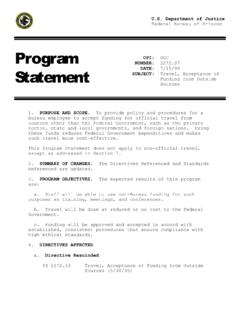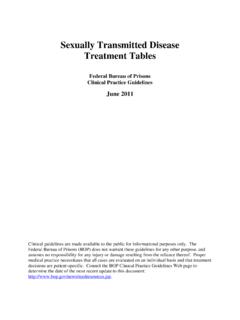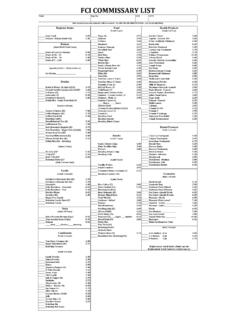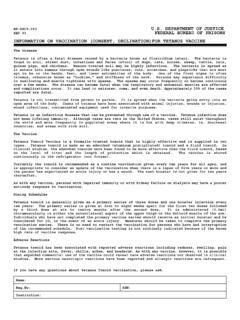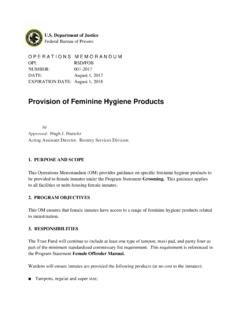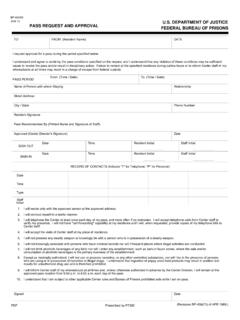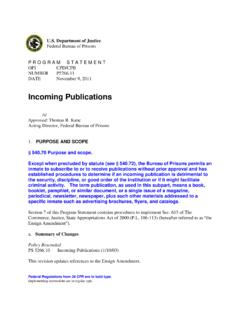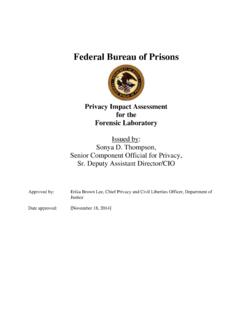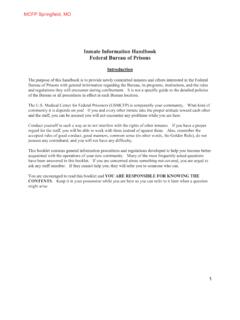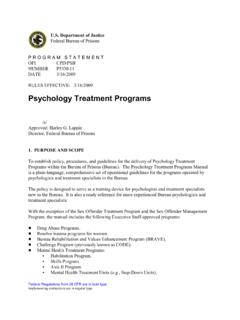Transcription of Management of Major Depressive Disorder
1 Management OF Major Depressive Disorder federal bureau of Prisons Clinical Guidance MAY 2014 (REFORMATTED OCTOBER 2017) federal bureau of Prisons (BOP) Clinical Guidance is made available to the public for informational purposes only. The BOP does not warrant this guidance for any other purpose, and assumes no responsibility for any injury or damage resulting from the reliance thereof. Proper medical practice necessitates that all cases are evaluated on an individual basis and that treatment decisions are patient specific. Consult the BOP Health Management Resources Web page to determine the date of the most recent update to this document: bureau of Prisons Management of Major Depressive Disorder Clinical Guidance May 2014 i WHAT S NEW IN THIS DOCUMENT?
2 NOTE: The formatting of this document was updated in October 2017. Revisions to the 2009 BOP Clinical Practice Guidelines for Management of Major Depressive Disorder include the following: The guidance has been revised to be in line with the Diagnostic and Statistical Manual of Mental Disorders, Fifth Edition (DSM-5) that was released in May 2013 by the American Psychiatric Association (APA). Accordingly, the following sections of the 2009 version of these guidelines have been deleted: Appendix 1, DSM-IV-TR Criteria for Major Depressive Episode Appendix 2, DSM-IV-TR Criteria for Major Depressive Disorder The DSM-5 criteria have been changed, and the DSM is now copyrighted.
3 Readers are referred to the DSM website at Changes were made in accordance with the Practice Guideline for Treatment of Patients with Major Depressive Disorder , Third Edition, issued in 2010 by the APA, and available as a PDF at: Additional updates were made as a result of a review by BOP psychiatry and pharmacy staff. federal bureau of Prisons Management of Major Depressive Disorder Clinical Guidance May 2014 ii TABLE OF CONTENTS 1. PURPOSE .. 1 2. INTRODUCTION .. 1 Natural History .. 2 Special 2 3. SCREENING .. 3 Screening Questions .. 3 TABLE 1. Screening Questions for Depression .. 4 Further Screening Methods .. 4 4. DIAGNOSIS.
4 4 Depression: Three Levels of Severity .. 4 Clinical Interview and Documentation of Risk Assessment .. 5 TABLE 2. Screening Questions for Risk of Suicide .. 5 TABLE 3. Risk Factors for Suicide or Violence Towards Others .. 6 Physical Examination and Laboratory Assessment .. 6 5. ELEMENTS OF SUCCESSFUL 7 7 Psychotherapy .. 8 Psychology Referral .. 8 Psychiatric Referral .. 8 Informed Consent .. 8 6. TREATMENT DURING ACUTE, CONTINUATION, AND MAINTENANCE 9 Acute Phase of Treatment .. 9 Continuation Phase of Treatment .. 11 Maintenance Phase of Treatment .. 11 Discontinuation of Treatment and Monitoring for Relapse .. 12 7. MEDICATIONS.
5 13 Factors to Consider .. 13 Stepwise Approach .. 13 TABLE 4. Stepwise Approach to Medical Treatment of Depressive Disorders .. 13 Drug Classes, Indications, and Dosing .. 14 Drug Washout Times (when changing antidepressant treatment regimens) .. 16 Drug Side Effects .. 16 Drug-Drug Interactions .. 16 federal bureau of Prisons Management of Major Depressive Disorder Clinical Guidance May 2014 iii 8. TREATMENT DURING PREGNANCY .. 16 9. INMATE EDUCATION .. 17 DEFINITIONS .. 18 REFERENCES .. 21 APPENDIX 1: PHARMACOLOGIC/TOXIC AGENTS THAT CAN CAUSE OR EXACERBATE Depressive SYMPTOMS .. 23 APPENDIX 2: MEDICAL CONDITIONS ASSOCIATED WITH DEPRESSION.
6 24 APPENDIX 3: ANTIDEPRESSANT MEDICATION INDICATIONS AND DOSING .. 25 APPENDIX 4: SIDE EFFECTS OF ANTIDEPRESSANT MEDICATIONS .. 26 APPENDIX 5: DEPRESSION TREATMENT AUGMENTATION STRATEGIES .. 27 APPENDIX 6: SEVERE DRUG-DRUG INTERACTIONS WITH MAOIS .. 28 APPENDIX 7: FOODS TO AVOID DURING TREATMENT WITH MAOIS* .. 29 APPENDIX 8: DRUG WASHOUT TIMES BETWEEN ANTIDEPRESSANT TRIALS .. 30 APPENDIX 9: FREQUENTLY ASKED QUESTIONS ABOUT DEPRESSION .. 31 APPENDIX 10A: INMATE EDUCATION ON DEPRESSION (INMATE QUIZ) .. 34 APPENDIX 10B: INMATE EDUCATION ON DEPRESSION (ANSWERS TO QUIZ) .. 35 APPENDIX 11: RESOURCES ON DEPRESSION .. 36 federal bureau of Prisons Management of Major Depressive Disorder Clinical Guidance May 2014 1 1.
7 PURPOSE The federal bureau of Prisons (BOP) Clinical Guidance for the Management of Major Depressive Disorder provides recommendations for the Management of depression in federal inmates. This guidance does not include recommendations for the medical Management of bipolar disorders, which requires other special treatment considerations. 2. INTRODUCTION Depressive disorders are one of the most common medical conditions seen in the primary care setting. Major depression affects between 5 10% of all patients, disproportionately affecting women and the elderly. The causes of Depressive disorders are unknown, but risk factors include: genetic factors, stress, bereavement, comorbid medical and psychiatric illnesses, certain medications, substance abuse, intoxication or withdrawal, cognitive impairment or brain injury, and a history of childhood trauma.
8 Despite the availability of highly effective treatments, Depressive disorders are frequently underdiagnosed and undertreated resulting in unnecessary patient suffering, lost productivity, and a marked increase in the cost of medical care. The direct and indirect health care costs associated with the Management of depression are greater than for all other medical conditions except ischemic heart disease. The diagnosis of depression should be considered for inmates who repeatedly present with unexplained somatic symptoms. As many as half of all primary care visits are for psychiatric conditions that present as medical complaints such as pain without significant organic cause, fatigue, dizziness, and sleep problems.
9 Depression should also be considered for inmates who present with certain psychiatric and medical conditions that are frequently associated with depression. Up to 62% of depressed patients suffer from another mental Disorder , most often some type of anxiety Disorder . Conversely, up to 70% of patients with anxiety disorders suffer from a Depressive Disorder . Comorbid conditions associated with depression also include: substance use disorders, somatoform disorders, personality disorders, schizophrenia, and dementia, as well as medical conditions such as thyroid disease, cardiac disease (particularly after bypass surgery), nutritional disorders, cancer with and without paraneoplastic syndromes, HIV infection, connective tissue diseases, diseases of the hypothalamic-pituitary-adrenal axis, and neurologic diseases.
10 Depression can also be precipitated or exacerbated by certain medications, including but not limited to steroids, narcotics, benzodiazepines, interferon, and reserpine. At least 80 90% of patients with Major Depressive Disorder can be brought into a full remission with appropriate medication or electroconvulsive treatment. However, despite the availability of highly effective treatments, only 20% of all primary care patients who are diagnosed with a Depressive Disorder receive adequate treatment. federal bureau of Prisons Management of Major Depressive Disorder Clinical Guidance May 2014 2 NATURAL HISTORY Depressive disorders can develop at any age, from childhood through late adulthood.
